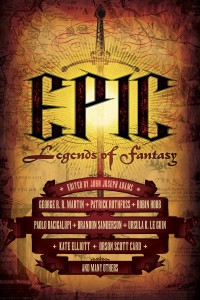I’ve been remiss in not talking about this one here, but I have to admit I’m a little disorganized and frankly I just forgot about it — until editor and anthologist extraordinaire John Joseph Adams reminded the world that this baby is out now:
EPIC, the ultimate anthology of short-form epic fantasy, from some of the biggest names in the genre and also newbies like li’l ol’ me.
Here’s the Table of Contents. Yeah, just bask in that for awhile. Then if you’re interested, it’s shipping already from Amazon and B&N in the US, and I suspect other retailers will have it up soon. My story in the volume is The Narcomancer, which, granted, is up free. But it’s also a sample of what kind of stuff you can find in this volume — self-contained short fiction set in some of your favorite epic fantasy story worlds, and maybe some new worlds you’ve never seen before.
I do think it’s hard to do epic fantasy well in short form. I’ve done it, a few times, but I have to admit that one of the reasons I write so many novels is because short stories frustrate the hell out of me sometimes. I mean, once you’ve invested so much in creating a complex, detailed world, it’s frustrating to just… stop. But every big world has little stories, and some of them can be quite powerful and profound.
I talk more about “The Narcomancer”‘s creation here. An excerpt:
Was this story a particularly challenging one to write? If so, how?
It kind of wrote itself, actually! I do wish I’d done more research before I wrote Ginnem, the male Sister. I’d intended for Ginnem to be a trans woman, but I worried that it wouldn’t seem plausible for a Bronze Age society to so readily accept a person with male organs who identifies as female. But if I’d done my research, I would’ve realized many ancient societies did just fine with transgender issues; it’s our (American in my case) modern society that’s hinky about it. So instead Ginnem is a transvestite–identifying as male, “performing” a female role because that’s what he has to do to belong to the Sisters. Still gotta do some learning in that area.
Check it out!

I just finished reading the story. I loved that the Sister was a man! I actually think that having him identify as male made the character much more complex. A former soldier that chose a path as a healer of souls–it speaks volumes for that character. I also enjoyed having a man performing a “feminine” role yet not loosing any of his masculinity, or turning him into some sort of joke. Very refreshing. I very much enjoyed the story, and the ending was beautiful. Thank you!
I’m glad to read this explanation of Ginnem. I read the story from an earlier link to it you posted where you said you’d written about trans women. Trying to read Ginnem as a trans woman is distracting, because between the male-assigned and the female-presenting, there is nothing about Ginnem’s gender identification, and the narrative consistently genders Ginnem male. I can imagine that some male-assigned Sisters are female identifying and some are not. Yay for diversity! (Actually, I’m struck by the idea of there being female-assigned, male-identifying Sisters, because if cis men can be Sisters, what is going to stop a trans guy if he’s called to it?)
I loved the story. And in terms of the gender stuff, I particularly appreciated Ginnem’s defence of his right to counsel/support a survivor of rape. His resigned, wearied amusement at Cet’s discomfort is definitely in character for a cross-gender person dealing with expectations of gender presentation/identification.
Given that Ginnem would not identify as trans in contemporary society (I don’t think, anyway), is there characters/space for characters in the Dreamblood books who would identify as trans in contemporary society? People who are known to identify (not just present) as other than their assigned sex?
Lex,
Oh, certainly — to my mind there are Sisters who are trans women, intersex, genderqueer (changing their identity as they see fit), men who choose to perform as women while still identifying as male (like Hanani performs male while IDing as female), and so on. There’s probably a Sister out there who’s biologically female, identifies as male, and performs as female only while performing his Sisterly duties; no reason that couldn’t happen. What matters is simply that peace is maintained, both for the person trying to fit into a given role and for the society at large.
The priest class of Gujaareh isn’t the only place where this kind of gender performance is expected; to my mind a gay or lesbian couple of any caste would be able to marry so long as one partner agrees to be the “wife” and one agrees to be the “husband”. There are legal and social expectations attached to each role — e.g. the wife may pass on property to any female children the couple adopts, but the husband may not, because property inheritance in this society is matrilineal. So as long as someone in the pairing chose to take on those responsibilities, the Gujaareen sense of propriety would be satisfied. There are also male-presenting female members of the military caste, and as the books mentioned, there have been female Princes. Those Princes all had to take 256 wives — but there’s nothing in the Wisdom that says those wives can’t have penises.
Thanks for giving more detail. (I forgot that I had to come back to check, hence the delay in replying again.) I am even more excited to read the books, now!